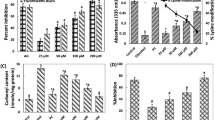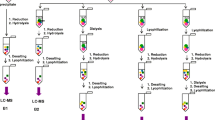Abstract
The purpose of this study was to investigate the effect of N-phenacyl-4,5-dimethylthiazolium bromide (DMPTB), an advanced glycation end product (AGE) cross-link breaker, on lens protein cross-links formed in vitro and in vivo. DMPTB was synthesized and its structure confirmed by its NMR spectrum. To show whether DMPTB can inhibit AGE cross-linking, recombinant human αA-crystallin was glycated with glucose-6-phosphate (G6P) in the presence and absence of DMPTB. Reversal of the already formed cross-links was studied by treating pre-glycated αA-crystallin with DMPTB. The ability of DMPTB to cleave in vivo formed cross-links was ascertained by treating water-insoluble protein fractions from diabetic human lenses with this compound. Glycation of αA-crystallin with G6P showed several high molecular weight (HMW) protein bands on the SDS-PAGE gel; DMPTB inhibited the formation of these HMW proteins. Molecular sieve HPLC confirmed the inhibition of formation of larger aggregates not separated by SDS-PAGE. Treatment of pre-glycated αA-crystallin with DMPTB gave evidence for the degradation of the already formed cross--linked HMW aggregates. Both molecular sieve HPLC and reverse-phase HPLC of the water-insoluble protein fractions from two diabetic human lenses showed that DMPTB could degrade a major portion of the cross-linked HMW aggregates to lower molecular weight proteins. This suggests that the cross-linked proteins in human lenses are formed predominantly by the advanced glycation process and cross-link breakers like DMPTB may have application for the intervention of protein cross-linking in the eye lens.
Similar content being viewed by others
References
Monnier VM: Toward a Maillard reaction theory of aging. In: J.W. Baynes, V.M. Monnier (eds). Maillard Reaction in Aging, Diabetes and Nutrition. Alan R.Liss, New York, 1989, pp 1-22
Perry RE, Swamy MS, Abraham EC: Progressive changes in lens crystallin glycation and high-molecular-weight aggregate formation leading to cataract development in streptozotocin-diabetic rats. Exp Eye Res 44: 269-282, 1987
Swamy MS, Abraham EC: Lens protein composition, glycation, and high molecular weight aggregation in aging rats. Invest Ophthalmol Vis Sci 28: 1693-1701, 1987
Brownlee M, Vlassara H, Cerami A: Non-enzymatic glycosylation and the pathogenesis of diabetic complications. Ann Intern Med 101: 527-537, 1984
Abraham EC, Swamy MS, Perry RE: Non-enzymatic glycosylation (glycation) of lens crystallins in diabetes and aging. In: J.W. Baynes, V.M. Monnier (eds). Maillard Reaction in Diabetes, Aging, and Nutrition. Alan R.Liss, New York, 1989, pp 123-139
Swamy MS, Tsai C, Abraham EC: Glycation mediated lens crystallin aggregation and cross-linking by various sugars and sugar phosphates in vitro. Exp Eye Res 56: 177-185, 1993
Matsumoto K, Ikeda K, Horiuchi S, Zhao H, Abraham EC: Immunochemical evidence for increased formation of advanced glycation end products and inhibition by aminoguanidine in diabetic rat lenses. Biochem Biophys Res Commun 241: 352-354, 1997
Zarina S, Zhao H, Abraham EC: Advanced glycation end products in human senile and diabetic cataractous lenses. Mol Cell Biochem 2210: 29-34, 2000
Hayase F, Nagaraj RH, Miyata S, Njorge FG, Monnier VM: Aging proteins: Immunochemical determination of glucose derived pyrrole formed during Maillard reaction. J Biol Chem 264: 3758-3764, 1989
Nagaraj RH, Shipanova IN, Faust FM: Protein cross-linking by the Maillard reaction: Isolation, characterization, and in vivo detection of a lysine-lysine cross-link derived from methylglyoxal. J Biol Chem 271: 19338-19345, 1996
Chellan P, Nagaraj RH: Protein cross-linking by the Maillard reaction: Dicarbonyl-derived imidazolium cross-links in aging and diabetes. Arch Biochem Biophys 368: 98-104, 1999
Padayatti PS, Ng AS, Uchida K, Glomb MA, Nagaraj RH: Argpyrimidine, a blue flurophore in human lens proteins: High levels in brunescent cataract lenses. Invest Opthalmol Vis Sci 42: 1299-1304, 2001
Dunn JA, Patrick JS, Thorpe SR, Baynes JW: Oxidation of glycated proteins: Age-dependent accumulation of N-(carboxymethyl)lysine in lens proteins. Biochemistry 28: 9464-9468, 1989
Brownlee M, Vlassara H, Kooney A, Ulrich P, Cerami A: Aminoguanidine prevents diabetes-induced arterial protein cross-linking. Science 232: 1629-1632, 1986
Swamy-Mruthinti S, Green K, Abraham EC: Inhibition of cataracts in moderately diabetic rats by aminoguanidine. Exp Eye Res 62: 505-510, 1996
Swamy MS, Abraham EC: Inhibition of lens crystallin glycation and high molecular weight aggregate formation by aspirin in vitro and in vivo. Invest Opthalmol Vis Sci 30: 1120-1126, 1989
Zhao W, Devamanoharan PS, Varma SD: Fructose-mediated damage to lens alpha-crystallin: Prevention by pyruvate. Biochem Biophys Acta 1500: 161-168, 2000
Devamanoharan PS, Henein M, Ali AH, Varma SD: Attenuation of galactose-induced cataract by pyruvate. Mol Cell Biochem 30: 253-263, 1999
Vasan S, Zhang X, Zhang X, Kapurniotu A, Bernhagen J, Teichberg S, Basgen J, Wagle D, Shih D, Terlecky I, Bucala R, Cerami A, Egan J, Ulrich P: An agent cleaving glucose-derived protein cross-links in vitro and in vivo. Nature 382: 275-278, 1996
Cooper ME, Thallas V, Forbes J, Scalbert E, Sastra S, Darby I, Soulis T: The cross-link breaker, N-phenacylthiazolium bromide prevents vascular advanced glycation end-product accumulation. Diabetologia 43: 660-664, 2000
Thornalley PH, Minhas HS: Rapid hydrolysis and slow α,β-dicarbonyl cleavage of an agent proposed to cleave glucose-derived protein crosslinks. Biochem Pharmacol 57: 303-307, 1999
Wolffenbuttel BHR, Boulanger CM, Crijns FR, Huijberts MS, Poitevin P, Swennen CNM, Vasan S, Egan JJ, Ulrich P, Cerami A, Levy BI: Breakers of advanced glycation end products restore large artery properties in experimental diabetes. Proc Natl Acad Sci USA 95: 4630-4634, 1998
Vaitkevicius PV, Lane M, Spurgeon H, Ingram DK, Roth GS, Egan JJ, Vasan S, Wagle DR, Ulrich P, Brines M, Wuerth JP, Cerami A, Lakatta EG: A cross-link breaker has sustained effects on arterial and ventricular properties in older rhesus monkeys. Proc Natl Acad Sci USA 98: 1171-1175, 2001
Shroff NP, Cherian-Shaw M, Bera S, Abraham EC: Mutation of R116C results in highly oligomerized αA-crystallin with modified structure and defective chaperone-like function. Biochemistry 39: 1420-1426, 2000
Laemmli UK: Cleavage of structural proteins during the assembly of the head of bacteriophage T4. Nature 227: 680-685, 1970
Perry RE, Abraham EC: High-performance liquid chromatographic separation of lens crystallins and their subunits. J Chrom 351: 103-110, 1986
Author information
Authors and Affiliations
Rights and permissions
About this article
Cite this article
Hollenbach, S., Thampi, P., Viswanathan, T. et al. Cleavage of in vitro and in vivo formed lens protein cross-links by a novel cross-link breaker. Mol Cell Biochem 243, 73–80 (2003). https://doi.org/10.1023/A:1021660105893
Issue Date:
DOI: https://doi.org/10.1023/A:1021660105893




